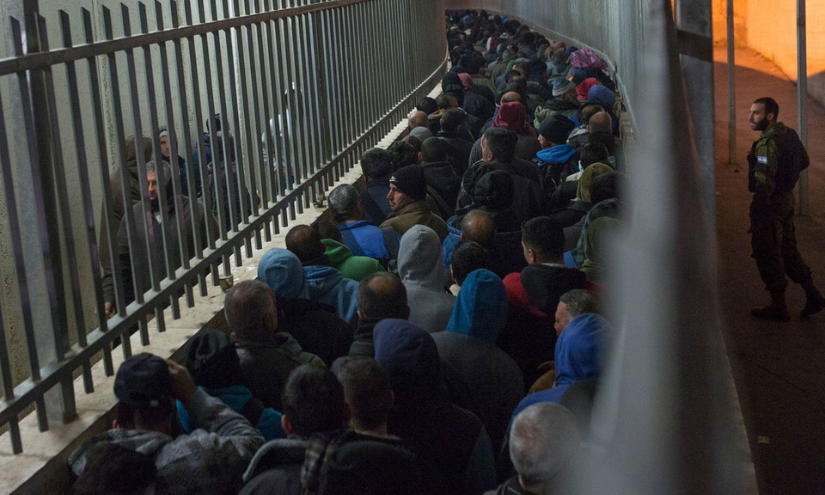The Palestinian Panopticon
Checkpoints on the border of Palestine and Israel as the architecture of occupation

On an average day, a Palestinian who works in Jerusalem and resides in the West Bank must wake up at four in the morning in order to arrive at work by nine. The reason is not the distance between workplace and home. With the construction of the separation wall that began in 2002, and is still underway as of 2022, the Israeli state entered into a new stage of encroachment on Palestinian territory.
The Palestinian worker has to wait in line for hours at checkpoints staffed by soldiers who are incentivized to make the line move as slowly as possible. Most of these border-crossers have a long day ahead of them in various kinds of construction work. After crossing into Israel, they must spend hours every day passing through checkpoints to get to work, even though they often have only a few kilometres to travel.
The short distance traversed by Palestinian workers who commute from the West Bank into Israel for work encompasses one of the most humiliating and dangerous journeys that can be undertaken by any human being. Recent films by Palestinian filmmakers shed light on the ongoing paradoxes of occupation. In 200 Meters (2020), Ameen Nayfeh chronicles the short but dangerous journey of the protagonist, Mustafa, as he travels a mere 200 metres in the boot of a car. The film is set in the Palestinian city of Tulkaram, which was one of the first cities to be bisected by the Israeli separation barrier. Mustafa needs to cross the Israel–Palestine border in order to see his son, who has been hospitalized by a car crash. He has to pay a smuggler to get him across the border, and nearly dies of suffocation on the way. He ends up journeying hundreds of kilometres, scaling walls, going undercover, and risking his life simply to get to the other side of the nearby border. Unlike in many comparable films, the protagonist’s journey is not far: the challenge he faces is how to cross a border a few miles away.
Hundreds of ‘envelope checkpoints’ (machsom keder), bisect Palestinian territory. These are also known as ‘flying check-points’, since they can be set up at any time and in just about anyplace, without warning. From January 2017 to June 2018, Israeli forces set up 4,924 flying checkpoints. While there are eleven terminal checkpoints in the occupied Palestinian territories, like Checkpoint 300, flying checkpoints populate most roads linking major Palestinian cities, often skirting the wall.
Checkpoint 300 is an advanced and semi-high-tech check-point that creates ‘the illusion of the occupation’s end while maximizing and stabilizing its techniques and effects’. Dividing Jerusalem from Bethlehem, this terminal checkpoint resembles a warehouse made of corrugated steel. During peak hours, the terminal is filled with thousands of Palestinians waiting to get to work. During non-peak hours, when fewer Palestinians are permitted to cross the border, its wide swaths of empty space are punctured by an atmosphere of endless waiting.
Although the terminal is large enough to house many thousands of passers-through, Checkpoint 300’s most desirable aisles are closed to Palestinians, even during the busiest hours. Special lanes are reserved for foreign visitors exiting the occupied Palestinian territories – a feature that makes legible the racial and ethnic distinctions that undergird the occupation.
The checkpoint edifice itself, crafted from corrugated steel and topped by a watchtower that overlooks the building, is a model of purpose-built efficiency. The shadows of the watch-tower eerily evoke the classical panopticon structure developed by utilitarian philosopher Jeremy Bentham. Bentham conceived of the panopticon as a means of enabling the observer to surveil an enclosed population without that population being able to see who is watching them. This eerie ubiquity of the jailor’s gaze is reproduced everywhere in the architecture of occupation.
While obstructing movement, the checkpoint’s turnstiles also convey the atmosphere of a rigidly organized occupation. However, notwithstanding the semblance of order that prevails in such terminals, which began to be constructed towards the end of 2005, there is little evidence that the checkpoints serve the purpose for which they were ostensibly built – that of ‘minimizing the damage to Palestinian life’.
Terminal checkpoints are built for display, partly to intimidate, but also to normalize the occupation and expand the mechanisms of surveillance. Introducing a new technology of governance, the terminal asserts the absolute power of the occupier over the occupied. Its architectural form epitomizes the permanent state of emergency through which the Israeli state justifies the occupation.
— Excerpted from Erasing Palestine: Free Speech and Palestinian Freedom by Rebecca Ruth Gould
[book-strip]
